For you to fully understand my love for my Panamax, I’m going to take you back to pre-Essen 2013 when my husband I did an MST3K inspired Essen Spiel excitement list. In the second edition of the list, a little game called Panamax appeared. If you really feel compelled to listen to us make up how the game is played, you can watch that here. It shows the old box art and board; from what I can gather, it was long before Stronghold Games got involved with the game. In any event, that’s when my desire for this game came into existence: October 2013.
Some time goes by and March 2014 hits. MESAboardgames & Stronghold were planning to release Panamax to coincide with the 100th anniversary of the Panama canal (spoiler alert: it coincided with Gen Con). This was my reaction to that news.

Needless to say I was pretty excited. Once I knew I was going to Gen Con, I had one goal: buy Panamax. Sure I wanted to do all the other Gen Con stuff, but my main goal was to buy this game. I even made a list.

I’m a girl with simple tastes what can I say? Games and food make me happy. Not surprisingly, I, in fact, bought Panamax at Gen Con. In case you haven’t heard, I bought more than one copy.
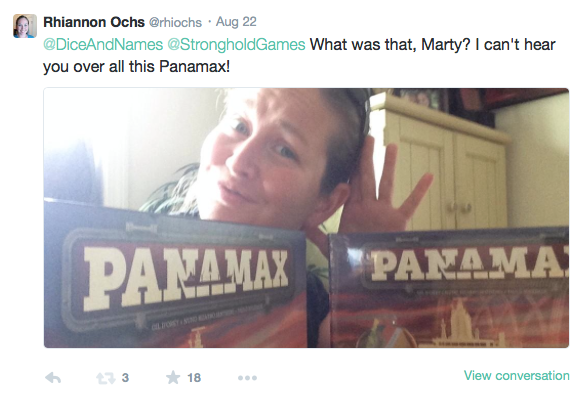
Cool your jets. I’m not a complete hoarder. I bought one for a local convention-type thing. Didn’t mean I wasn’t going to be obnoxious about owning more than one when so many people were complaining about not having one. I realize you’re not here to recount my love affair with this game, but I thought it was important to establish that I’m not some silly skirt talking about the hottest new game just because.
Aerial View of Panamax
Panamax is a 2-4 player game about shipping cargo through the Panama Canal designed by Gil d’Orey, Nuno Bizarro Sentieiro, and Paulo Soledade. Each player assumes the role of a manager of a shipping company. Players need to balance the acquisition of contracts and loading and shipping of cargo all while making sound financial decisions and investments for their company and themselves. The player with the most personal money at the end of the game wins.
How It Works

Generally, the game isn’t that difficult. The games lasts for three rounds with four turns per player and there are three main things players can do on a turn: get contracts/load cargo (Grey Zone stuff), move ships (Blue Zone stuff), and invest in companies. In addition, players have to manage two unique sources of income: Company assets and personal fortunes.
Dice are rolled at the beginning of each round to determine the available actions and arranged in the Action Table.
The Action Table is divided into two halves: the Movement Actions (Blue Zone) and the Contract/Load Cargo Actions (Grey Zone). Each zone has three columns for the placement of dice; at the top of each of these columns are Executive Actions, one per column. Executive Actions let you either do the action associated with column from which the die was taken or invest in a company or raise the value of a company’s stock.
Players must choose the lowest die in a given column and perform the associated actions (or they can relocate a die following a set of conditions).
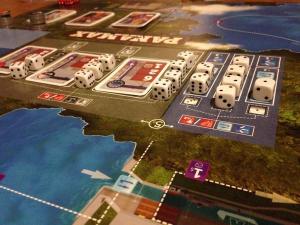
Blue Zone
Water Movement: When choosing a die from the Blue Zone, you will move ships through locks and waterways for the full amount of movement granted by the action, which means you will likely be moving ships that aren’t yours.
When you remove a die, there will be a specific number of Waterway Movement icons revealed. You have to move ships exactly that number of waterway movements. Depending on which column you pick from – first, second, or third – you have to move ships that many Lock Movements – 1, 2, or 3 respectively.
Ships can be grouped in any combination up to 4 slots. Groups can be formed by ships in the same and adjacent Loading Zones or in the same half of a lake.
There is a super awesome pushing mechanic that allows the “back” ship in the canal to push all the ships in front of it through locks. The pushing stops once the ships hit open water (lakes and oceans), but can be very powerful because movement is only counted for the ship doing the pushing no matter how many ships it pushes.
Grey Zone
Choosing Contracts: Taking contracts is an optional part of the Grey Zone and allows you to get more cargo to load onto ships.
If you choose to take a Contract, you load dice onto the card with dice from the Warehouse then the Dice Pool (this order is important because of fees paid at the end of the round). Each Contract displays a flag symbol, which tells you in which Loading Zone the cargo from the contract must go. On the back of each Contract card is a generic cargo option that always has a value of three and can be loaded on a ship in any Loading Zone or the Rail Table if applicable. Once a Contract is complete (all dice have been loaded), receive the Flag from the country on the card and place it on your Company Clipboard. If it covers a Free Action, immediately play that action.
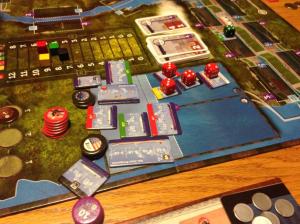
Loading Cargo: Loading Cargo lets you put cargo onto ships in Ocean Zones.
When you remove a die from a Grey Zone column, you will expose a certain number of loading icons. The number of exposed icons dictates how many pieces of cargo you can load on to ships. The cargo can come from any Contract card that contains cargo, not just the one taken that turn. If you didn’t take a contract card this turn, you will still be able to load cargo based on the number of revealed icons.
Ships range in size from one slot to four slots. Each ship also has a range of numbers printed on them illustrating the value the sum of the dice must fall between. A ship can take a single die less than the minimum value but needs to at least meet the minimum to be able to journey through the canal. If the placement of a die exceeds the range of the ship, the die cannot be placed on it.
There are several other rules about loading cargo, but these are the main ones:
- You can only take a contract if you have enough dice available between the Warehouse and Dice Pool to fill the contract.
- You can only place one die on the same ship per turn without a special action from Clipboard Free Action or a Stevedore card.
- If there is a Rail symbol next to a piece of cargo, that piece must be placed in the Rail area. If the Rail is full, the die sits on the Contract card (and costs you money) until the Rail becomes available in the next round.
There are special ships that have special loading rules. Cruise ships can only hold 1 or 2 dies and give you Passenger tokens instead of money. Military ships don’t hold any passengers and earn your personal income based on movement rules. The San Juan Prospector is bad ass and doubles the value of one of your dies once it exits the canal.
Speaking of exiting the canal, ships earn money or rewards when they exit a canal. Each Company receives $1 per pip on their own dice on the exiting ship. The owner of the ship receives a bonus card (extra movement, extra loading, or end-game bonuses) or additional money into his personal assets based on the size of the ship(s) that exited. Dice go into the Dice Pool, and the ships are placed in the Waiting Zone of the Ocean Zone they just entered.
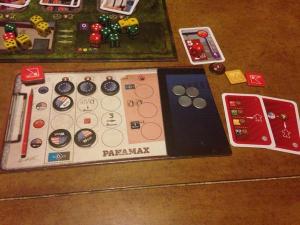
Market Actions
The Market Table tracks the value of each player’s company. It shows the current market price on the left and the dividend payout on the right.
Buying Shares: Players can buy shares in one of two ways: a Free action from the Clipboard or from an Executive Action. As long as shares are available, a player can buy shares from any company at its current market price.
Raising Company Stock: When using an Executive Action die, a player has the option of increasing their company stock by $2. If they choose to do this instead of purchase stocks, they simply move their marker up two spaces in the table.
End of a Round
A Round ends when the last die is taken from the Action Table. At the end of a Round, several things happen. Dice in the Rail table shift, determining player turn order for the next round, and players pick a Flag. Cargo fees are paid per die in a given zone, ranging from $1-$4. Dice left in the Warehouse cost $5 per die. Dice left on an incomplete Contract card cost $4 per die. A Company pays dividends. Managing Directors are awarded. If a Company cannot pay its fees, there’s bailout money they take and will owe back to the Bank.
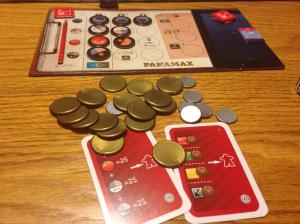
End of a Game
At the end of the third Round, each player will add up all the following:
- Money from their personal assets
- Their best two Financial Advisor Cards
- Managing Director Awards (if any)
- Selling their shares to the Bank at the current market price of the corresponding companies
- Pay off Bailout tokens
The player with the most personal assets at the end of the game wins. Turn order breaks ties.
Thoughts on the Game
Panamax is an incredible example of mechanic-theme integration in a heavy-ish euro. It’s not a hard game, but it’s a complex one. Paying attention to where cargo can and can’t be loaded and when ships can and can’t be moved can take some getting used to. There is a lot to have to pay attention, not unlike, I imagine, what running a shipping company in Panama might be like.
What I Don’t Love About It
The money. Martin Wallace money? Seriously?
The amount of whining about the game. I read the other reviews on the geek, and I get it. The game has tough choices. Sure, the contract cards can screw you because there aren’t any ships in the proper Ocean Zone, but here’s a thought: use the generic cargo side, or, I dunno, pay attention to the cargo on the contract you are taking to make sure it is actually useful not just full of high-numbered dice. Or don’t take a contract. Don’t like your turn order? Take advantage of the actions that send you to the Rail first and highest. Don’t like the available actions? Move the dice. Yeah, sure, it’s expensive at first, but there are things you can do to alleviate that; move some tourists, complete one contract from each country.
None of this means the game isn’t balanced. It doesn’t mean it sucks. In fact, it could be the perfect game (which I’d say it falls closer to than not), and you could still not like it because it’s just not your type of game. I love this game, but I wouldn’t recommend it to most people I know. It’s not for everyone; very few games are. Anyway, that’s enough venting.
Two player play. Two players isn’t a bad experience, but having played it with three and four, it’s not the best way to experience it. The rules themselves cite it as a variant (same with three player). There is significantly less of the “you scratch my back I’ll scratch yours” thing going on. In my experience, it was me putting my stuff on my ships and my husband putting his on his. You have the same amount of actions, but the game feels more like multi-player solitaire in this setup. So, while the game still offers something good for the two-player experience, there are better games for two players. Yeah, I said it.
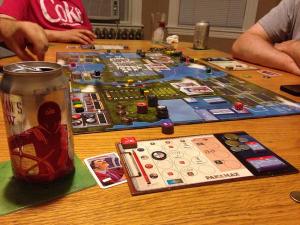
What I Love About It
The theme. I love it. It’s so boring yet it fascinates me. It’s something concrete that I can relate to (although I do like me some abstract games). I completely immerse myself in its theme, and it’s a place I’m happy to be.
The cooperative competitiveness. I heard this in a couple videos, and it’s a perfect way to describe this game with four players (and to a slightly lesser extent with three). You’re not just figuring out your moves, you’re figuring out how to force others to make those moves for you. It creates a very interesting dynamic that I enjoy immensely.
Max players. Honestly, this is a four-player game. That’s where it shines. The beneficial screwage element is great. I’m going to get you to do what I need done, and oh my goodness, did pushing those ships just move you into a higher price bracket? Oopsie daisies. I obviously played this game with like-minded people, which means they “got” it. I don’t exactly remember the scores, but I feel like they were reasonably spread amongst the four of us. The person who won had an awesome last turn with free actions and stock manipulation whereas the person who lost (I think) took a bailout token early on. Anyway. Four players. Do it!